Visit Omis: The Summertime Holiday Winter Dreams Are Made For
17 December 2020 – Missing adventure, escape, breathtaking landscapes and unspoiled nature? Visit Omis in 2021 - with 20 kilometres of perfect beaches and crystal-clear seas, the mighty Cetina river and an atmospheric Old Town, it's the summertime holiday that winter dreams are made for.
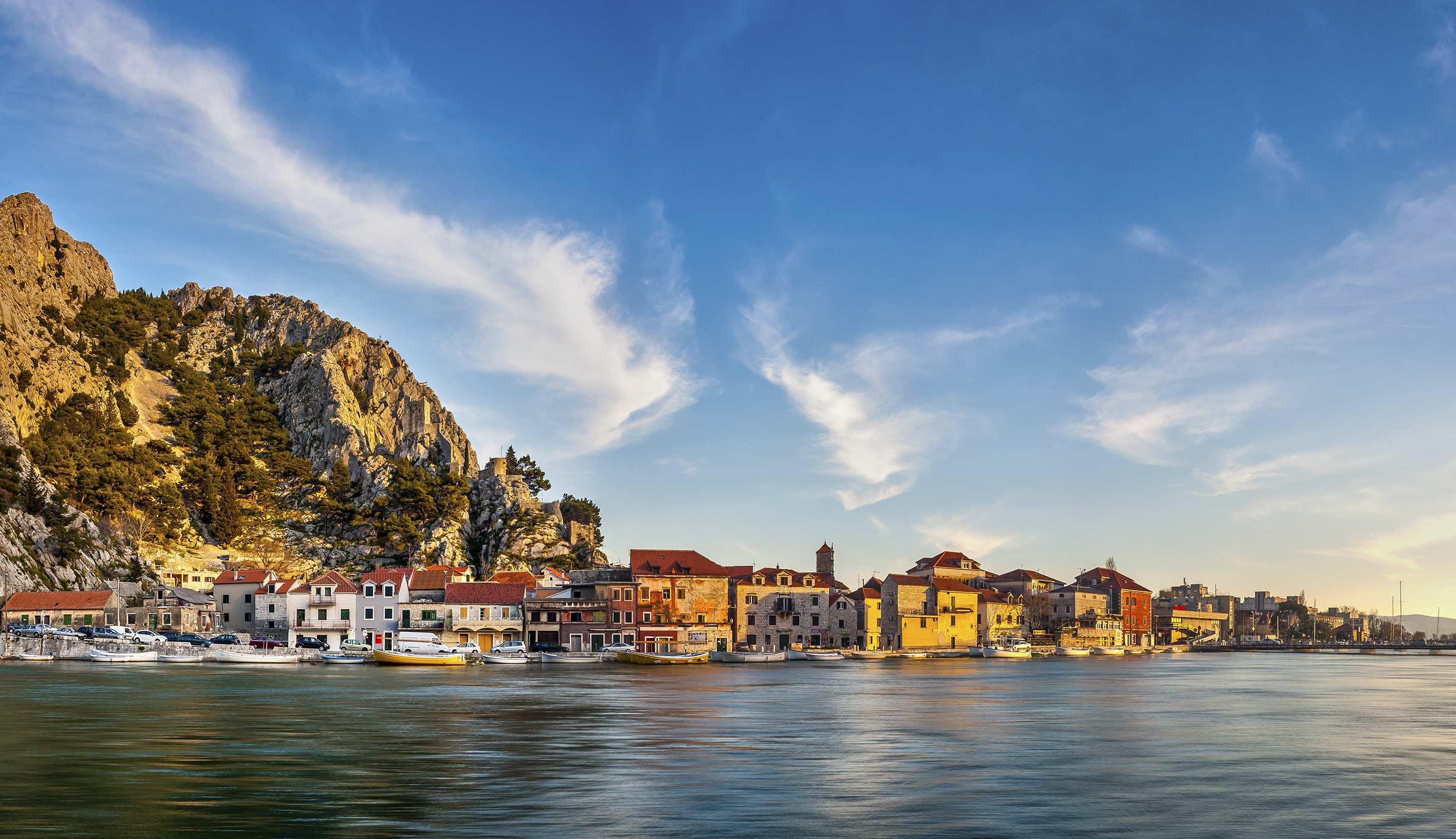 The pretty pastel shades of buildings in Omis contrast beautifully against the sheer, grey, karst rock which rises sharply behind © Omis Tourist Board
The pretty pastel shades of buildings in Omis contrast beautifully against the sheer, grey, karst rock which rises sharply behind © Omis Tourist Board
The cold outside is often reason enough to spend most of winter indoors. It's a good time for wrapping presents or even wrapping yourself in blankets. Perhaps, if it snows, you'll sit by the window, daydreaming. With a chill in the air, there's no better dream than that of next summer. In the warmth of the summer sun, you can forget all about those blankets and staying indoors. It's time for escape, adventure, the great outdoors, to hit the beach and to swim in the sea.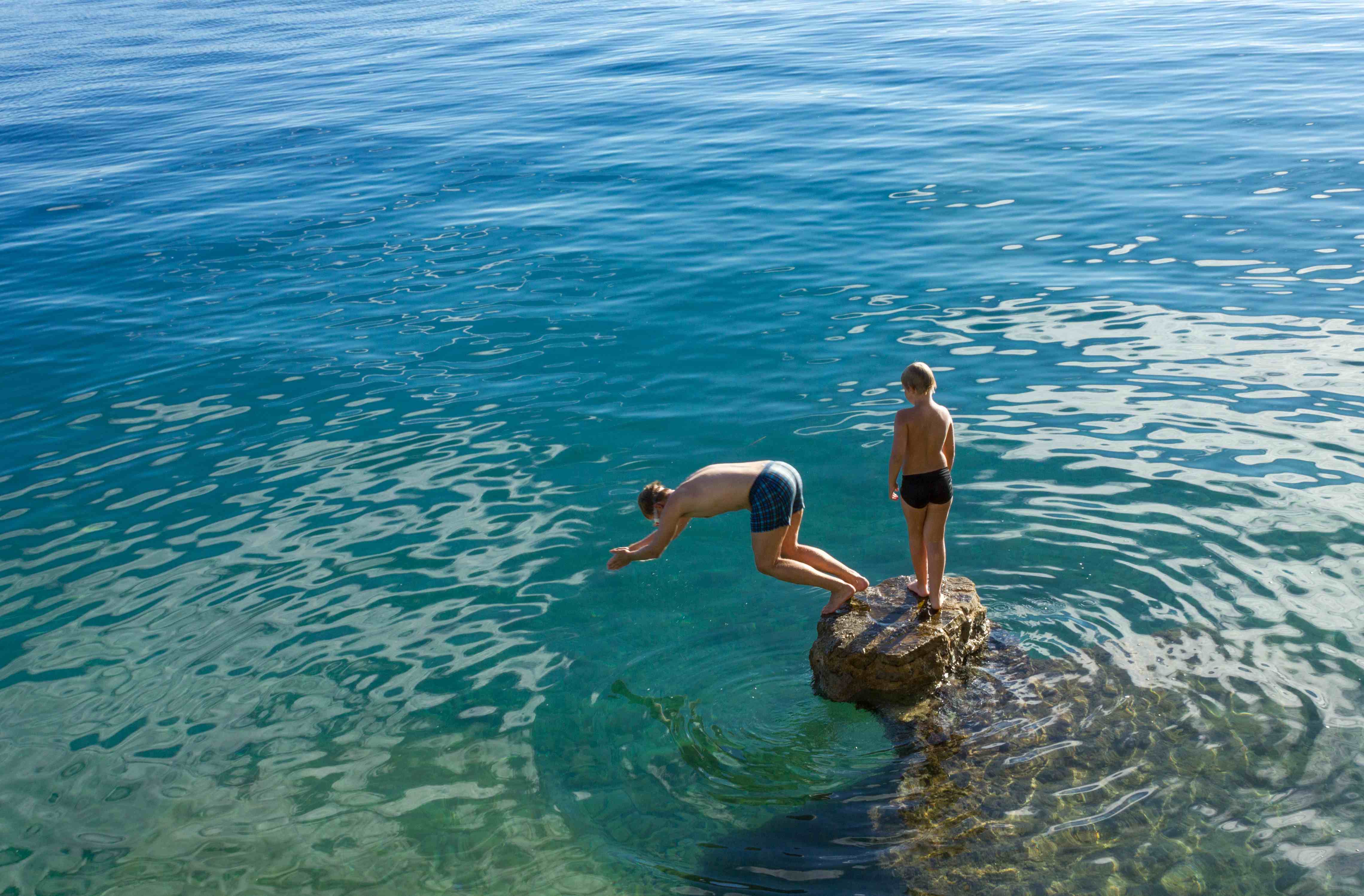 Crystal-clear waters run along the length of the Omis riviera © Omis Tourist Board
Crystal-clear waters run along the length of the Omis riviera © Omis Tourist Board
In 2021, the City of Omis will once again welcome winter's dreamers. From Springtime to October, visitors will come and enjoy its extended summer, many of them returning as they do every year. Because, once you visit Omis, there really is nowhere else that can match its incredible offer.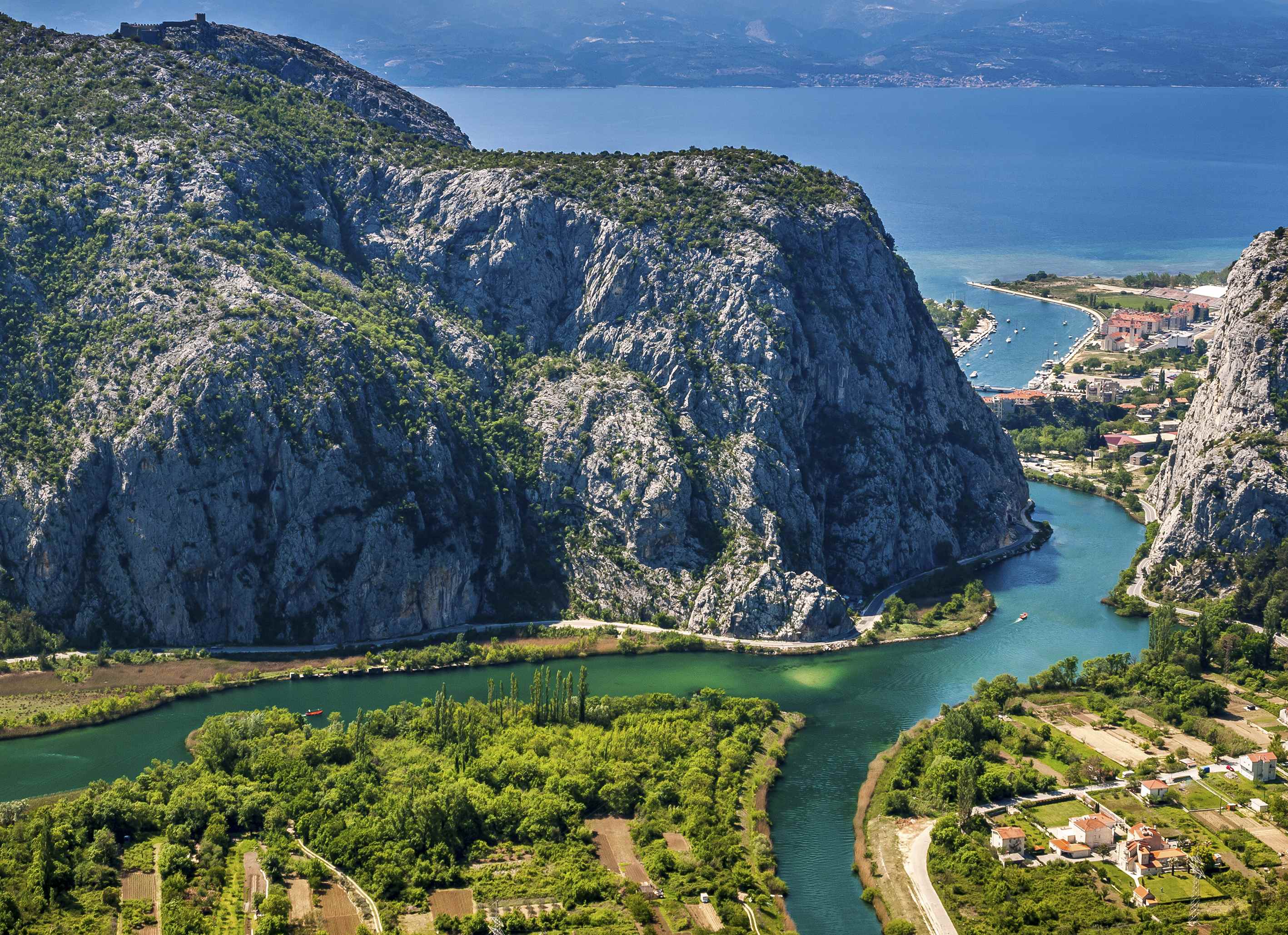 A spectacular landscape, with the lush Cetina river valley cutting through the Dinaric Alps to flow into the sea at Omis - you can see the island of Brac in the distance © Omis Tourist Board
A spectacular landscape, with the lush Cetina river valley cutting through the Dinaric Alps to flow into the sea at Omis - you can see the island of Brac in the distance © Omis Tourist Board
The unique experience when you visit Omis is a product of a singular history and geography. Standing on the mouth of the Cetina - the largest river in Croatia to drain into the Adriatic – Omis and its surrounding riviera is not only filled with pristine and peaceful beaches, it also has waters that, for hundreds of years, have connected the city far into the hinterland. When you visit Omis, it is this riverside positioning that gives its unmissable adventures, culture, heritage and nature.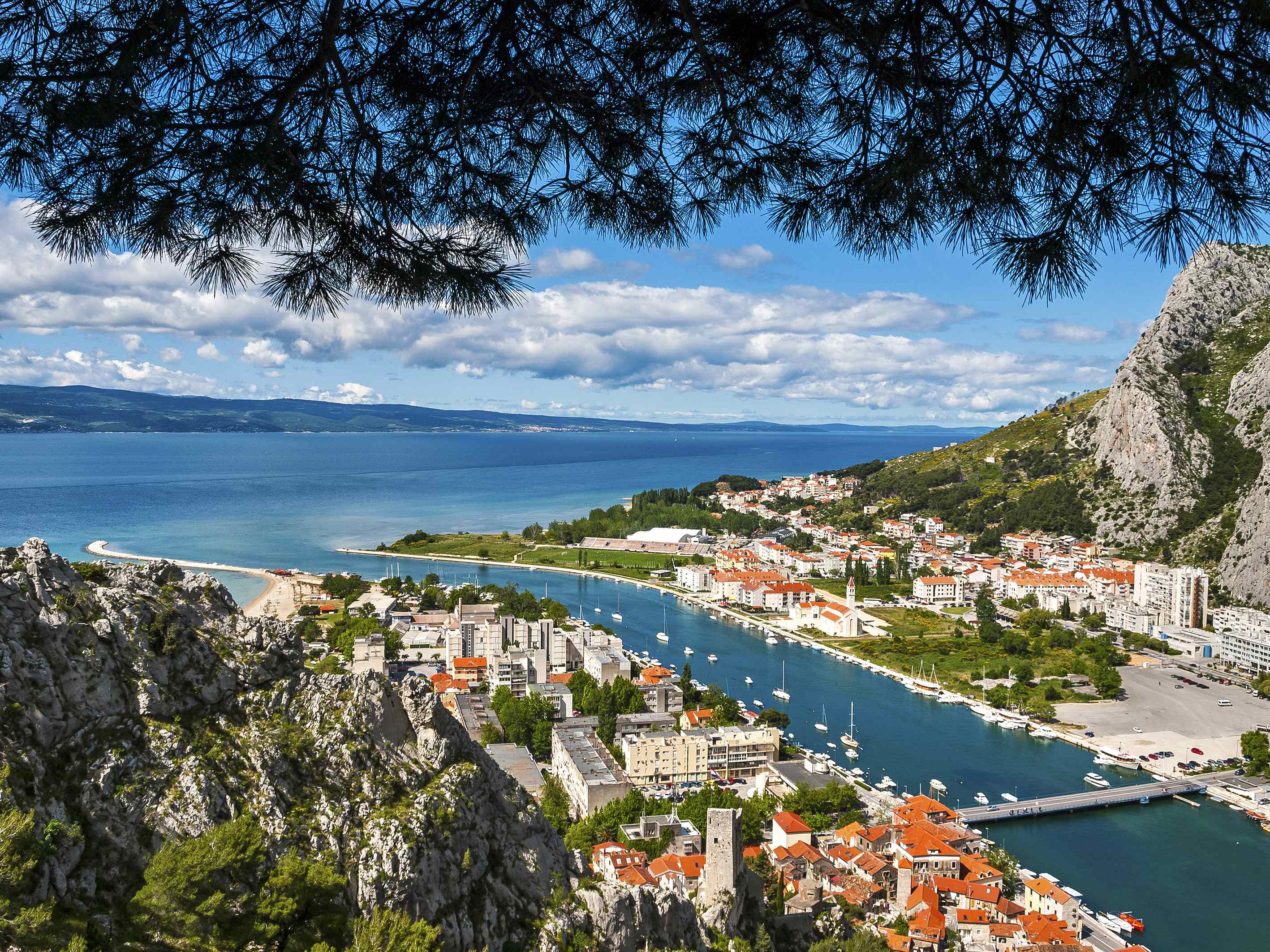 The Cetina river is the largest to flow into the Adriatic in Croatia and helps give Omis a truly unique offer © Omis Tourist Board
The Cetina river is the largest to flow into the Adriatic in Croatia and helps give Omis a truly unique offer © Omis Tourist Board
Omis has been inhabited since at least Roman times. Today, the winding, narrow streets of its Old Town are a pretty promenade with a distinctly Mediterranean atmosphere. Walking down these stone-paved pathways, intriguing architecture built over centuries is revealed – an unexpected city square opens up, seating drinkers and diners. Above them, the walls of an ancient church and beyond, the spectacularly lit Mirabella fortress that stands impressively above the town. You can easily walk to the top and look over the Old Town and river or, by day, take the path further back, up to the 15th century Starigrad Fortress. Its walls are renowned to hold one of the greatest views in Croatia, the island of Brac dominating the skyline, further still, the island of Hvar. Both can be toured by boat on day trips when you visit Omis.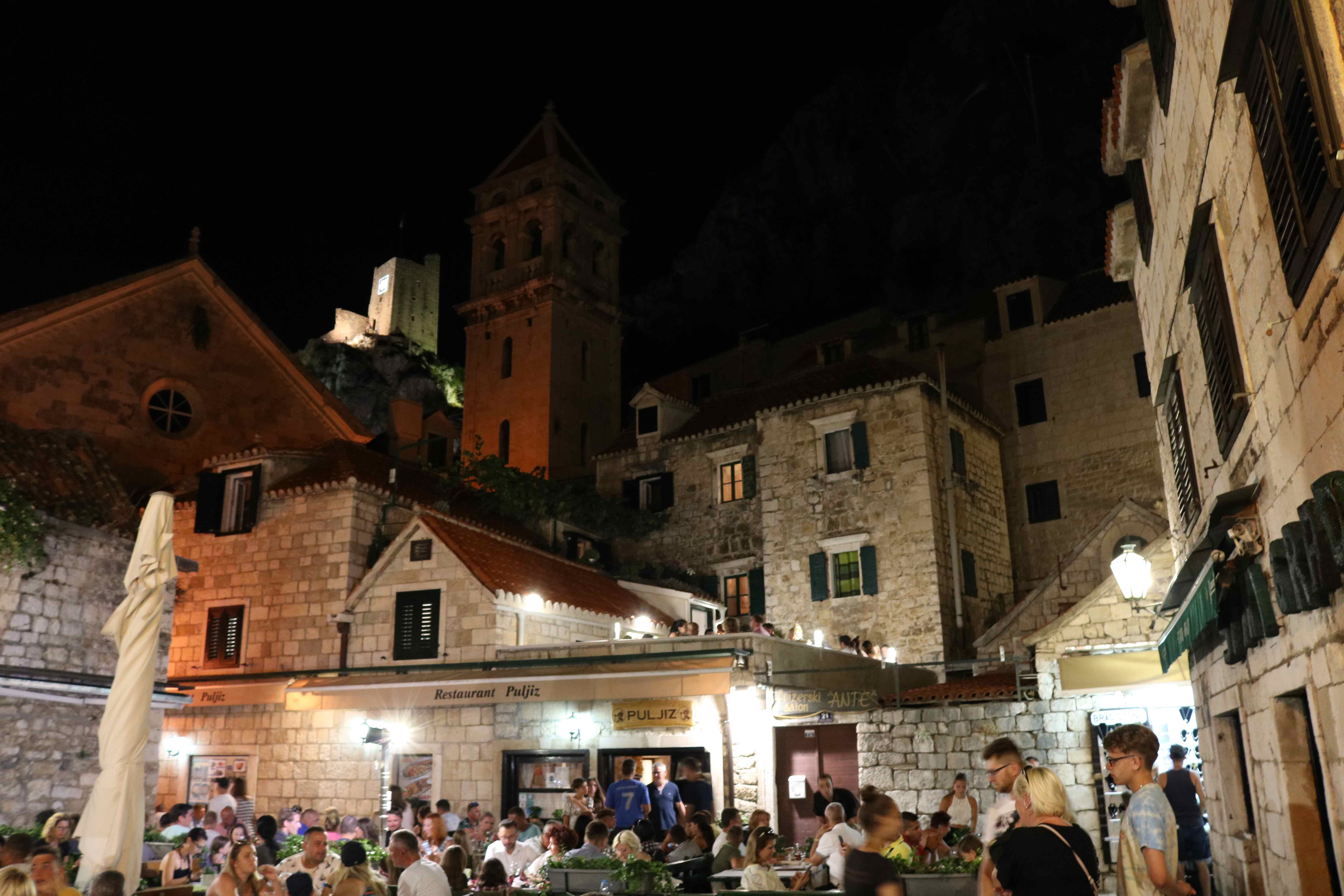 The atmosphere-filled Old Town of Omis © Marc Rowlands
The atmosphere-filled Old Town of Omis © Marc Rowlands
Besides venturing out to sea by boat, taking to the waters of the Cetina river is the best way to get the most from the unique offer when you visit Omis. You can kayak from the town into the nearest sections, watching as the pastel shades of Omis buildings are replaced by the towering, epic cliffs of grey karst rock, sometimes dotted with brave and experienced free climbers. Then, suddenly, the river widens to become flanked by reeds, then fields and trees. Birds sit atop the water or fly overhead, fish dart below you in crystal-clear waters, insects and frogs can be heard coming from some hidden place. The whole landscape seems alive, yet silent except for the sounds of nature – you can't hear a single car engine, not the buzz of an overhead cable, only the dipping of your oar in the calm waters.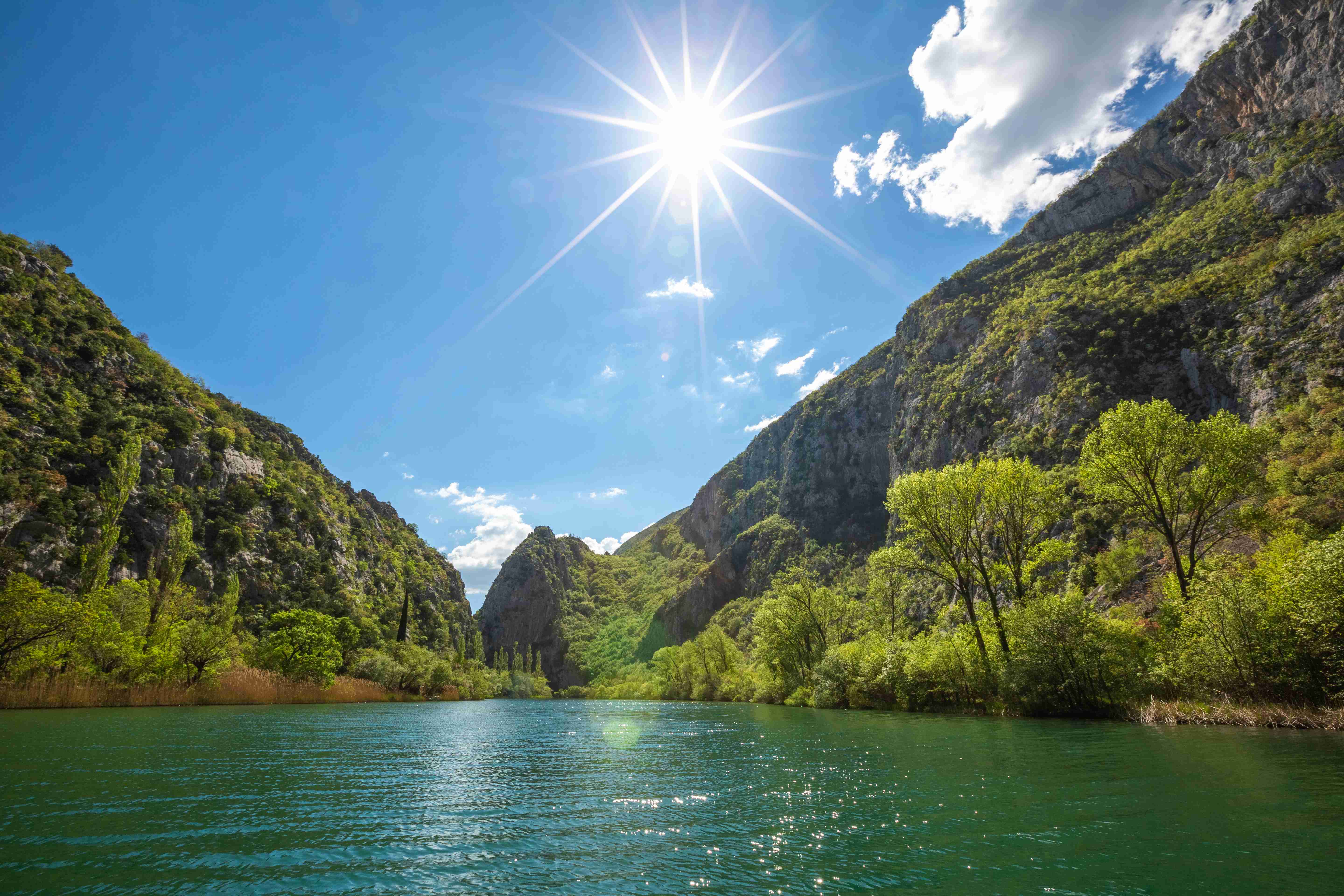 The still and silent Cetina river valley near Omis, perfect for kayaking and reconnecting with nature © Samir Kurtagić / Omis Tourist Board
The still and silent Cetina river valley near Omis, perfect for kayaking and reconnecting with nature © Samir Kurtagić / Omis Tourist Board
Further up the river, the sounds are not so silent. Thrillseekers scream as they fly down the longest run of ziplines in Croatia – a series of eight lines, at times rising 150 metres above the river, the scenery of mountains and surging river is breathtaking, as feet whistle over high treetops. Further up the river, rapids produce white waters perfect for rafting. Although an action-packed run of over two-hours duration, it's an undemanding course taken by many families with children as young as six. Between the fast-moving sections are waterfalls that spray the air and peaceful pools where you pause to swim. At one of the largest stands a huge picnic area, serviced by a restaurant specialising in the rustic cuisine of this part of the Dalmatian hinterland. Thick-crusted, homemade bread is made within metal bells atop wood fires, the perfect accompaniment to local cheeses, prosciutto and seafood.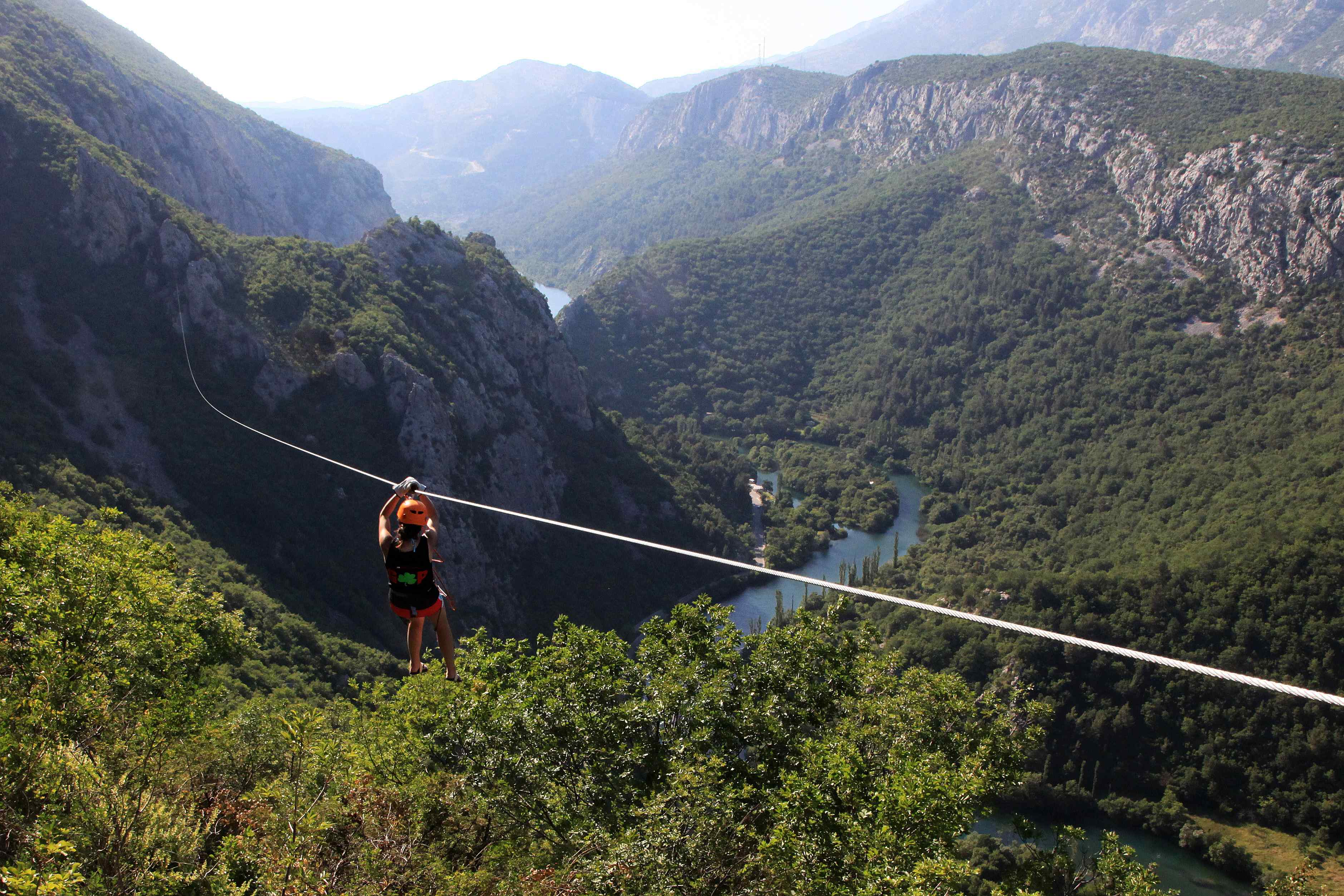 © Zipline Croatia
© Zipline Croatia
Here, away from the shoreline of the town, countless small villages appear on the roads between the river and mountains. Life in these villages looks remarkably like it did a few hundred years ago. The same fruits and vegetables and vines still grow around the traditional houses, many of them ending up on the tables of the fine restaurants you'll dine in when you visit Omis. The same meals are prepared, such as Soparnik, one of Croatia's most authentic dishes – you can only find it in the small region surrounding Omis. The same folk dances are preserved, and the same songs fill the air. You can hear many of them in Omis itself – the city hosts a famous 55-year-old festival of klapa (acapella) music, its singers dressed in traditional clothes, their voices echoing around the stone streets of the Old Town in the same way they have for hundreds of years. The chamber music evenings and one of the most important guitar festivals in the region add to the wonderful entertainment and atmosphere of balmy summer evenings you have when you visit Omis.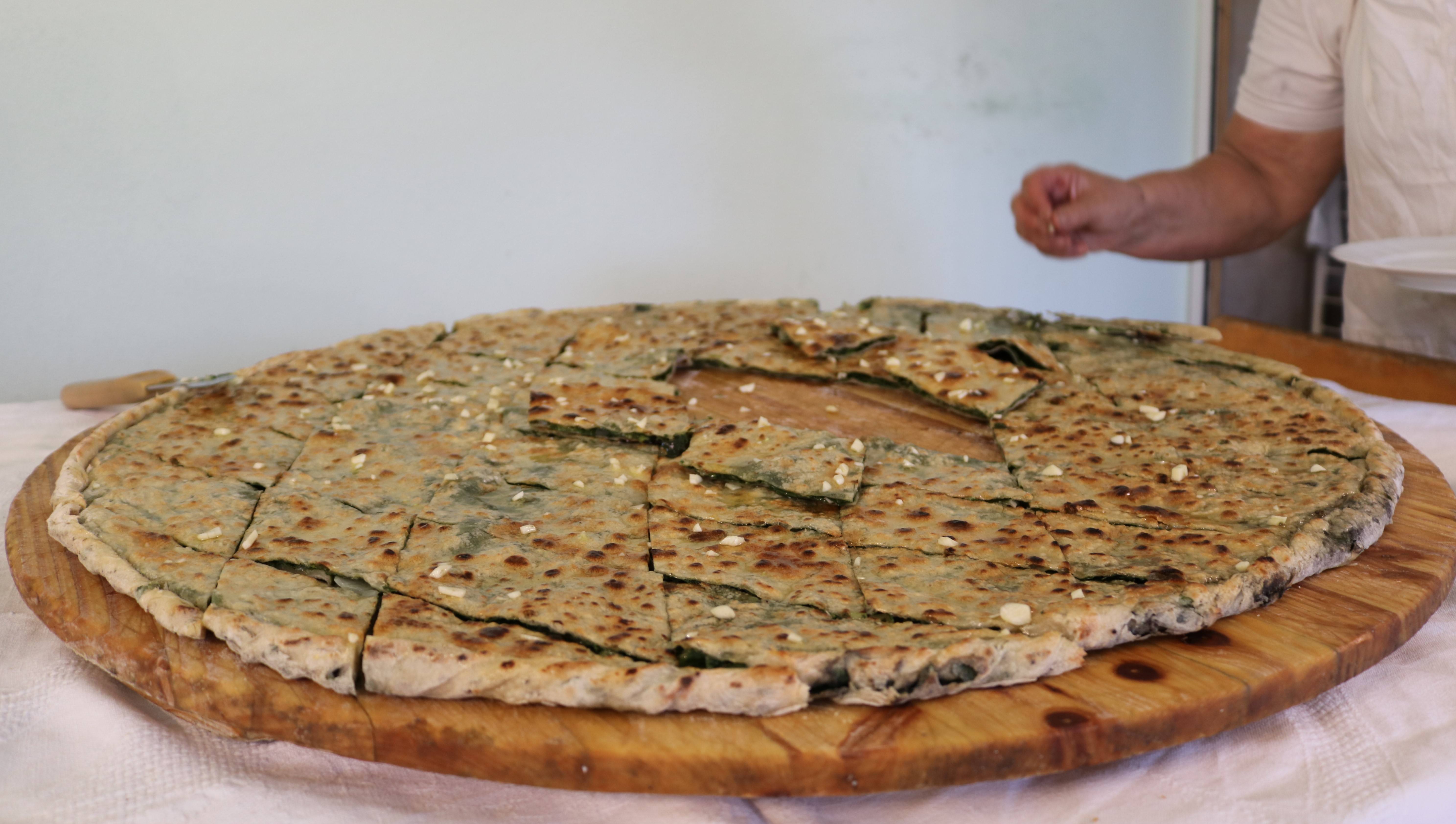 Soparnik, one of the most authentically Croatian foods in the country. It comes from the hinterland behind Omis and it's unlikely you'll find it anywhere else © Marc Rowlands
Soparnik, one of the most authentically Croatian foods in the country. It comes from the hinterland behind Omis and it's unlikely you'll find it anywhere else © Marc Rowlands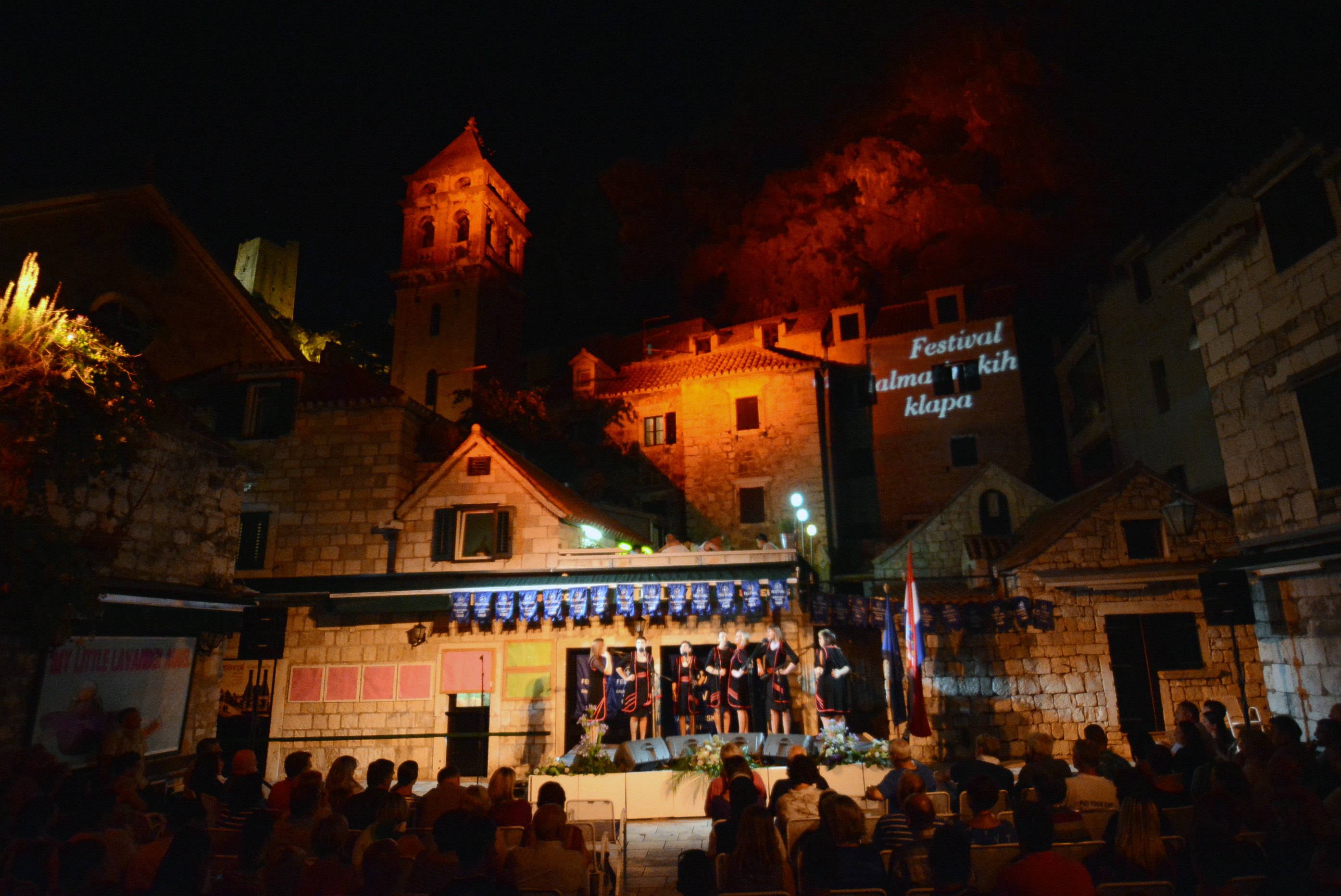 The 55-year-old festival of klapa music in Omis © Omis Tourist Board
The 55-year-old festival of klapa music in Omis © Omis Tourist Board
Of course, no trip to the Adriatic is complete without time spent on the beach and swimming in the sea. And, when you visit Omis, you're in one of the best places anywhere in Croatia to enjoy it. Relatively undiscovered, the Omis riviera has a wide range of options to suit all. Want to stay close to town? Visit Omis city beach – it's right on your doorstep, popular with families and its waters famously clean. It is extremely rare to find a huge sandy beach like this, right in the heart of the city.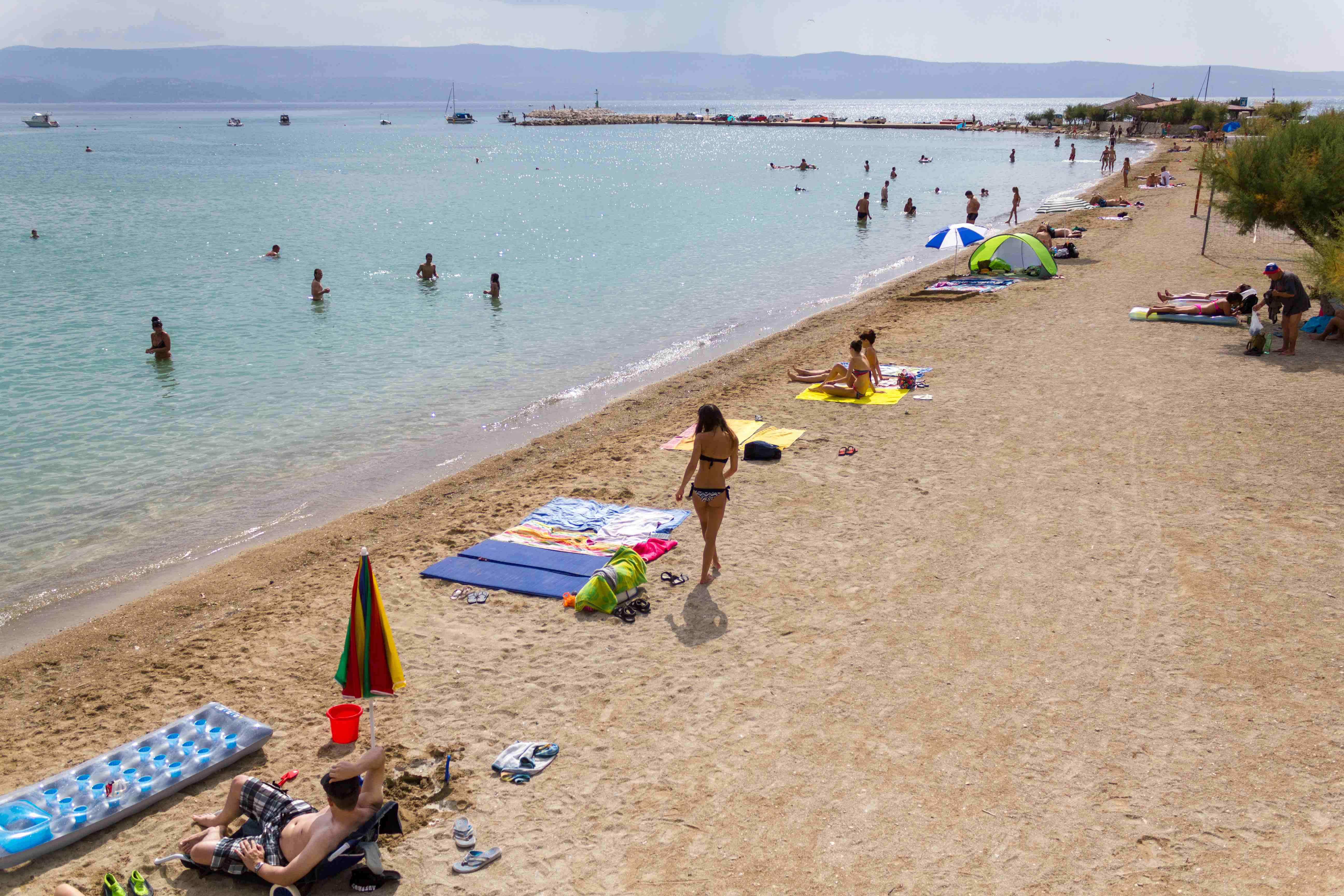 Omis city beach, a huge stretch of sand, moments walk from the centre - there's plenty of room for everyone © Omis Tourist Board
Omis city beach, a huge stretch of sand, moments walk from the centre - there's plenty of room for everyone © Omis Tourist Board
A short ride down the coast offers a 20-kilometre stretch of perfect small-pebble beaches, shaded by scented pine trees, sitting on impossibly clear waters. Pretty hamlets and fishing villages like Nemira, Stanici, Ruskamen, Lokma Rogoznica, Medici, Mimice, Marusici and Pisak allow you to chose between peaceful seclusion, diving and watersports or flavour-packed lunchtime dining in a traditional Dalmatian tavern.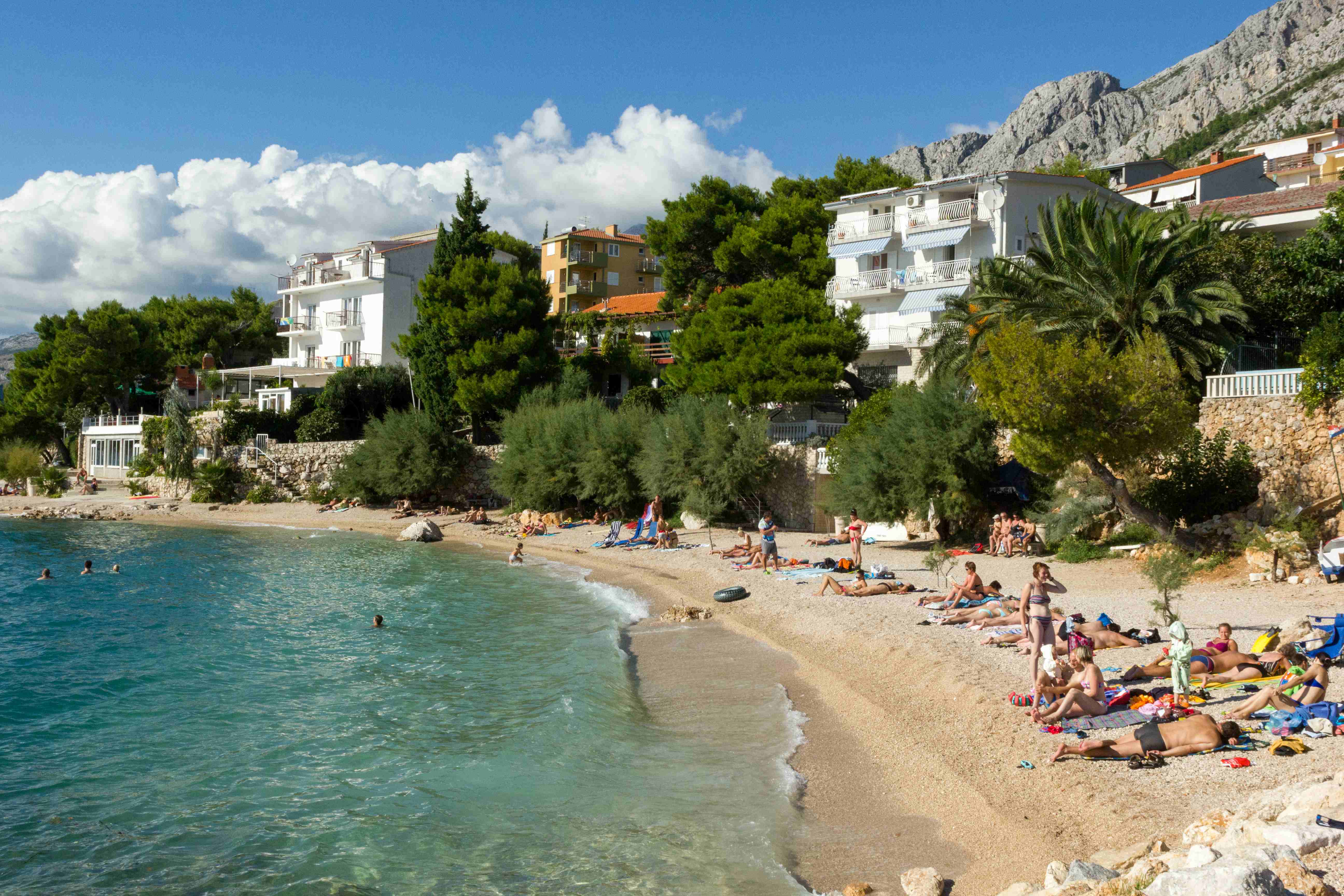 The village of Nemira, one of the countless pristine beaches along the 20 kilometres of the Omis riviera © Omis Tourist Board
The village of Nemira, one of the countless pristine beaches along the 20 kilometres of the Omis riviera © Omis Tourist Board
This winter has long to go. We will be inside for quite some time yet. But, that gives us plenty of time to dream of next summer. Of all the places you think you'd like to be, once the warm days return, the City of Omis and its riviera should be top of the list. Unique in its offer of adventure, nature, culture and heritage, there really is nowhere else like it on the whole of the Adriatic.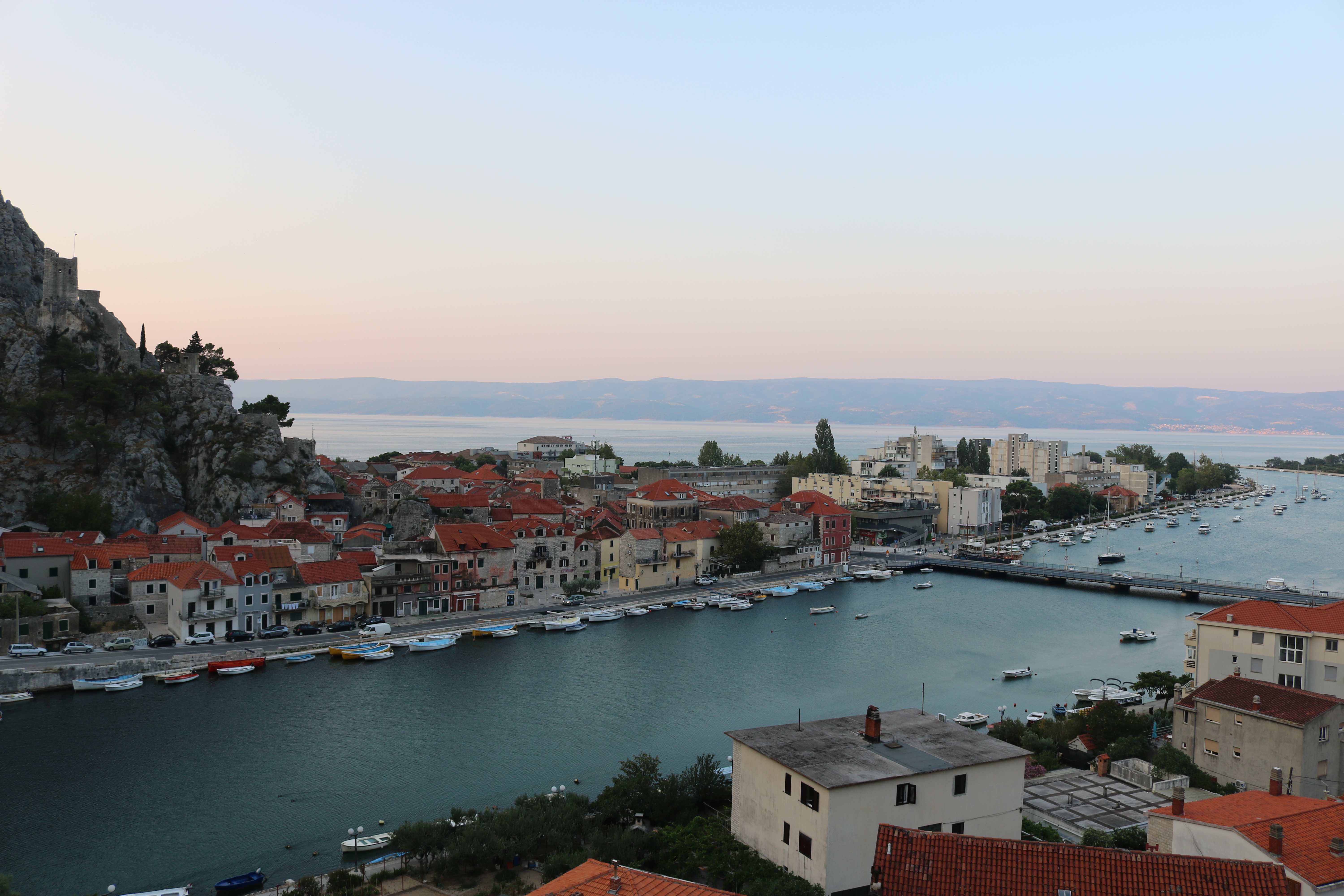 Daybreak over Omis, as seen from the restaurant balcony of Hotel Villa Dvor. The hotel's restaurant is the best place to take coffee in town, the view is spectacular © Marc Rowlands
Daybreak over Omis, as seen from the restaurant balcony of Hotel Villa Dvor. The hotel's restaurant is the best place to take coffee in town, the view is spectacular © Marc Rowlands
This article was written by TCN journalists based on first-hand experience of visiting Omis and was subsequently approved by Omis Tourist Board
Learning Croatian: Did the English Language Originate from Hvar Dialect?
December 17, 2020 - Continuing our alternative look at the Croatian language with linguisitic colossus Professor Frank John Dubokovich, is the English language actually derived from Hvar dialect?
One of the most popular features in the early years of Total Hvar, the precursor to TCN, was an impromptu language series I recorded with my good friend, Frank John Dubokovich, with whom I would share a late morning cold one each day on the square in Jelsa.
Frankie, of Jelsa stock but born and raised in New Zealand until his family moved back to Hvar when he was 8, is trilingual, although there is a case for saying not all of his language is understandable. He is fluent in English, Croatian and the very unique Hvar dialect. And it was his expertise in Hvar dialect that catapulted him first to a national televsion audience, and then to an international one, as he gave Croatian language lessons - at least his version of Croatia - to participants of a British reality TV show.
Professor Frank John Dubokovich, Guardian of the Hvar Dialects, as he quickly became known, was an Internet hit, with more than 50,000 views on his iconic Dalmatian grunt, before YouTube removed my channel for some reason.
Thankfully, I came across some offline versions of some of the Professor's teachings recently, and TCN is gradually reintroducing these linguistic treasures to the online world.
Today's lesson shows the depth of the Professor's intellect and capacity for detailed research. After toying around with his Hvar dialect, the Professor noted a number of similiarities between Hvar dialect and the English language. He enlisted the assisted of Jelsa Mayor, Niksa Peronja, to present his findings to his faithful audience. You can see the results in the video above - conclusive stuff.
The only thing left to explore is the following conundrum. Were English speakers the first inhabitants of Hvar, or is Hvar dialect actually the birth of the Croatian language?
You can see more of the Professor's linguistic genious on the TCN Talks YouTube channel.
Highlander Programme 2021: International Success for Croatian Brand
As Poslovni Dnevnik/Marta Duic writes on the 17th of December, 2020, three friends from the Eastern Croatian city of Osijek, Igor Mlinarevic, Jurica Barac and Andrej Mlinarevic, are passionate lovers of mountains and hiking. They officially presented the Highlander programme 2021 in front of the Egyptian pyramids in Giza, not far from Cairo.
The organisers of this mountaineering event have devised a Highlander mountaineering story, which is slowly conquering the whole world and becoming a global phenomenon. As they say, the reason for choosing Egypt as the location for the presentation of the Highlander programme 2021 lies in the fact that the Egyptian Bedouins, a nomadic people, were some of the first hikers in the world. One of the most important goals of this event is the promotion of an active and healthy lifestyle through hiking, as well as the preservation and care of nature by promoting the so-called Leave No Trace philosophy, and their wish is that in the future, the Highlander event manages to obtain the status of "100% Green Event".
Interest is growing...
Here in Croatia, Highlander is held on Velebit, and in 2020, it was held for the fourth time. The group also record a continuous growth of participants. Back in 2017 there were 60, and this year there were an impressive 330. In addition, Highlander has other variants in countries such as Serbia (Stara Planina), Bosnia and Herzegovina (Blidinje), Montenegro (Durmitor) , Austria (Murau) and Greece (Olympus), and at a press conference held in Egypt, new countries announced their own ''joining'' to the list; Morocco (Toubkal), Portugal (Melgaço), Northern Macedonia (Ohrid), Spain (Duero-Douro), Saudi Arabia (Abha), the United Arab Emirates (Ras Al Khaimah), Slovenia (Julian Alps), Russia (Caucasus) and Egypt (Qusoor El Arab).
Namely, at the beginning of 2020, this team sold the Highlander license to four neighbouring countries: Serbia, Bosnia and Herzegovina, Austria and Greece. As such, Highlander Global became an umbrella organisation that oversees existing and new Highlander countries, and in 2021, there will be about 15 Highlander events held around the world.
''After three years of developing this event here in Croatia (Highlander Velebit), we decided to sort out a franchise last year because we'd created a concept that doesn't currently exist, has an excellent business model and isn't demanding to implement. As such, at the end of 2019, we sold licenses to Austria, Serbia, Bosnia and Herzegovina and Greece.
As soon as 2020 came around and as soon as we announced new markets, we started talks with our partners around the world and negotiated the sale of the license to other countries. Then the coronavirus pandemic struck and everything slowed down, but fortunately, there are entrepreneurs who see an opportunity in everything, including the pandemic, and it's with these visionaries that we've agreed on ten more markets for 2021. The main motives are the huge growth of interest in outdoor sports, great interest in adventures such as Highlander and mountaineering tourism development strategies that are increasingly common due to their sustainability, positive impact on human health and an additional influx of guests,'' says Jurica Barac, the director of Highlander.
For the latest travel info, bookmark our main travel info article, which is updated daily.
Read the Croatian Travel Update in your language - now available in 24 languages
Draft of New Measures in Croatia: Reintroduction of Passes, Max Gathering of 2 Households
December 17, 2020 – As Index.hr first reports, a draft of new measures in Croatia has been prepared, according to which all current measures should be extended, with several new restrictive measures. The new measures will be officially announced tomorrow, announced Prime Minister Andrej Plenković.
The Civil Protection Headquarters and the Government of the Republic of Croatia are currently working on the final details of the new, stricter measures that will be in force in Croatia after December 21, 2020. The draft of the new measures, which would be valid from Tuesday, December 22, includes the introduction of passes and a ban on gathering people from more than two households.
Reduction in the number of people at gatherings
New measures will prohibit leaving the place of permanent residence, which would mean the return of passes. Another restrictive measure, which, as Index reports, is a ban on gathering people from more than two households. This provision will certainly remain in the final decision on the measures, but it is not yet entirely sure in what form. Namely, there are proposals to limit gatherings to one household, but for now, it is a more likely option with two households.
The ban on cafes will remain in force, and restaurants will remain closed to guests. Cinemas and theaters will not close; neither will hairdressers and other salons. The headquarters believe that cinemas and theaters currently pose a minimal risk because they do not have many visits. Salons also remain open with the explanation that they do not pose a significant risk given the number of people in them at the same time, wearing masks and adhering to other measures.
Shops and shopping centers are regulated by another decision, which further limits the number of people inside. It is valid until January 10, and there will be no change.
An additional reduction in the number of people at gatherings is considered. However, in the ongoing conversations, the question was asked how much it makes sense because the numbers are still minimal. Gatherings take place in private spaces where the possibility of control is limited.
'The chances of introducing passes are about 70 percent'
The passes have already been included in the draft, and if there is no reversal today, this measure will also be in force after December 21, 2020. As Index learns from a reliable source, the movement restriction will apply between counties, and the City of Zagreb and Zagreb County will again be one unit, as was the case at the end of the lockdown in the first wave.
Due to the large number of passes issued in the first wave, more than a million of them, it is considered that inter-county movement should be allowed only to employees of services who need it and in rare exceptional cases.
It is also possible that a particular decision on passes, for this reason, will not be formalized immediately on Friday, but subsequently, during the weekend, when all the rules that will apply to passes would be defined.
"It will take us another six months to get all the vaccines and to vaccinate enough of the population. If we do not adhere to the measures, it is necessary to introduce formal restrictions, although there is no success in the measures without personal engagement. New measures are currently being prepared. The goal is to do everything to spend the holiday season in the most peaceful way possible. We are now fighting in terms of the clinical picture for a better January. It is necessary to reduce mobility," said Prime Minister Andrej Plenković at today's government session.
Cafes and restaurants closed until further notice
"It seems to me that the chances of introducing a ban on leaving the permanent residence, or the introduction of passes, are about 70 percent at the moment. It is tragic that some people probably think that someone's goal is to make Christmas and the holidays bitter. Restricting movement is something we are reluctant to think about, but we expect it to reduce contact, which is extremely important to us this holiday season. Otherwise, there will be a tough situation after the holidays, despite some positive developments in recent days. Something must be done to prevent the spread of the infection for the holidays. Unfortunately, the introduction of such measures is necessary because of the small number of people who do not want to abide by the appeal and the simple measures we have to endure until the end of the epidemic, which is getting closer," a well-informed interlocutor told Index.
The new measures should be valid until January 8, 2021, when passes will be abolished. Still, most other measures would be extended for another two weeks to see what consequences the holiday gatherings will have on the numbers of newly infected and consequently dead.
According to the Index's information, among the measures that would be extended beyond January 8 is the ban on working in cafes and serving guests in restaurants until further notice.
"The infection cannot spread if we do not socialize and meet others, and we do not adhere to that enough. We must give our contribution. If that were the case, we could relax the measures," Plenković said.
To read more about coronavirus in Croatia, follow TCN's dedicated page.
For the latest travel info, bookmark our main travel info article, which is updated daily.
Read the Croatian Travel Update in your language - now available in 24 languages.
LEN Champions League: Jug Records Three Wins in Three Games
December 17, 2020 - The Jug AO water polo club from Dubrovnik secured their third victory in the Champions League Group A tournament in Ostia, Italy, after beating Greek Olympiacos 9-8 (0-1, 2-4, 3-0, 4-3) on Wednesday.
In the first two quarters, Olympiacos outplayed Dubrovnik, leading 5-2, and at the beginning of the third quarter, they also had a penalty, which was defended by goalkeeper Toni Popadić. This was followed by a turnaround, and by the end of the third quarter, Paulo Obradović scored two goals, and Daniil Merkulov and Jug equalized for 5-5.
In the last quarter, although Jug was constantly in the lead, Olympiacos kept the game equal. However, in the last three minutes, the Dubrovnik side inched ahead with goals by Loren Fatović and Paul Obradović for the 9-7 lead. By the end of the match, Olympiacos had only managed to mitigate the defeat.
Paulo Obradović was the most efficient for Jug with four goals. Loren Fatović scored two, and Javier Garcia, Marin Tomasović and Daniil Merkulov scored one goal each, while goalkeeper Toni Popadić collected 12 saves. Olympiacos was led by Marios Kapotsis with three and Konstantinos Genidounias with two goals.
Previously, in the Group A tournament of the Champions League in Ostia, Italy, Jug defeated Marseille 11-10, and German club Spandau 13-7.
Most importantly, Jug took all 9 points in Ostia. In the last ten matches in the Champions League, this is the sixth victory of Jug, the third on neutral ground (twice in Budapest) plus one in Piraeus, and two in Gruz. They also have two victories against Olympiacos, both at home, with two draws, both in Greece.
The second Champions League tournament is played from March 1 to 5, 2021, (four rounds) and the third from April 19 to 22, 2021 (three rounds), while the final tournament, Final 8, is in Hanover from June 3 to 5, 2021.
Source: Slobodna Dalmacija
To read more about sport in Croatia, follow TCN's dedicated page.
Split Advent To-Go: A Restaurant Guide to Festive Pick-Up Points, with Holiday Fare, Mulled Wine and More
December. 17, 2020 - The holidays may look a bit different this year, but that doesn't mean we can't find ways to enjoy the magic of the season safely. One way is with Split Advent to-go!
With the current government restrictions in force, which have closed restaurants, bars, and cafes until further notice, it's been challenging to enjoy Split Advent as we know it. However, these difficult times have forced catering facilities to get creative, and festive food and drink pick-up points outside our usually popular Split restaurant locations seems to be the way forward.
Over the last week, a handful of Split restaurants have announced pick-up points, dressed up in Christmas decorations, where you can indulge in to-go versions of your favorite Advent fare, mulled wine, hot gin, and restaurant classics, all while admiring the twinkling lights around the city.
Terminal F
Start at the top of the Riva at Terminal. F, whose food offer includes everything from homemade sausages, creamy taquitos, and meaty sandwiches to churros, cannolis, and fritule. If you're thirsty, there is mulled wine, hot gin, and Somersby apple punch, in addition to a selection of rakija shooters.
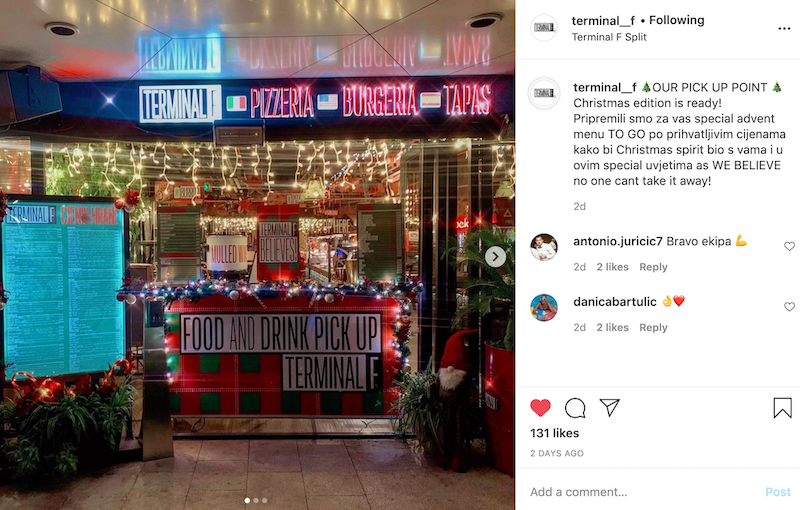
Dujkin Dvor
At the end of the Riva and on your way to the West Coast is Dujkin Dvor, where you can find fritters, sausages, cod, mulled wine, coffee, rum punch, and tea. And you can also drop off your letters to Santa!
Chops Grill
Because everyone's favorite steakhouse in Split couldn't hold out, either. Make your way up Marmontova and turn left at Chops Grill for coconut hot gin, Jager Meister Scharf punch, or Christmas gin tonic. But that's not all - there is a selection of bites, from hot dogs to savory croissants, cod, sausages, and eggburgers!
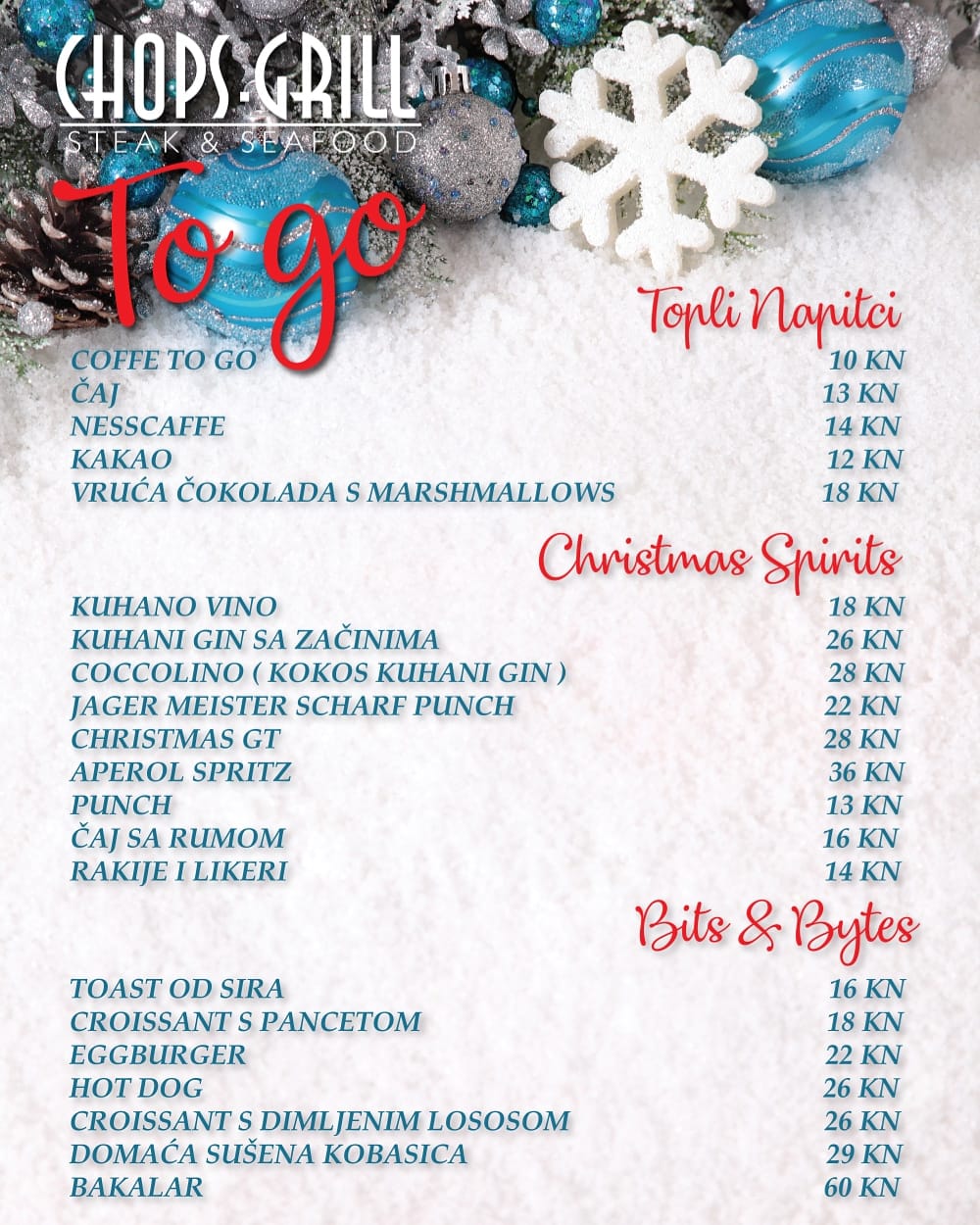
Articok
Just around the corner from Chops is Articok, with an extensive menu at their restaurant pick-up point. From a selection of soups to goulash, rabbit gnocchi, tripe, ravioli, cod, and cannoli, this is only part of what Articok has to offer!
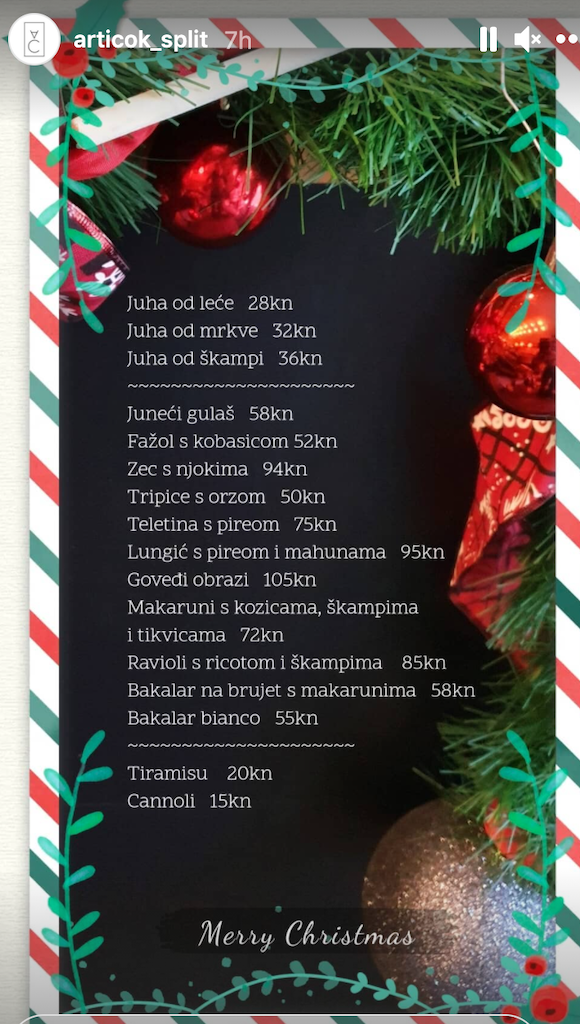
Corto Maltese
With coffee-to-go from 9 am and mulled wine, hot gin, tea, beer, lasagna, gnocchi, cod, risotto, and more from the afternoon, Corto Maltese's pick-up point is up and running for all your to-go needs!
Bokeria Kitchen & Wine (Jingles)
One of Split's most popular restaurants has promised to bring the holiday spirit to the city with a festive pick-up point outside their famous location. Available on Wolt, too, Bokeria has prepared caesar salad, beef tartare, fish tacos, burgers, black risotto, and, of course, bakalar, wine, and more!
Bon Vivant
Feel like street-food-style pierogies? Hot pelinkovac (made from four types of Pelinkovac, homemade tangerine marmalade, ginger, apple, citrus, and spices)? Beetroot soup? Bolognese? Or fresh juices? Look no further, as you can have it all at Bon Vivant!
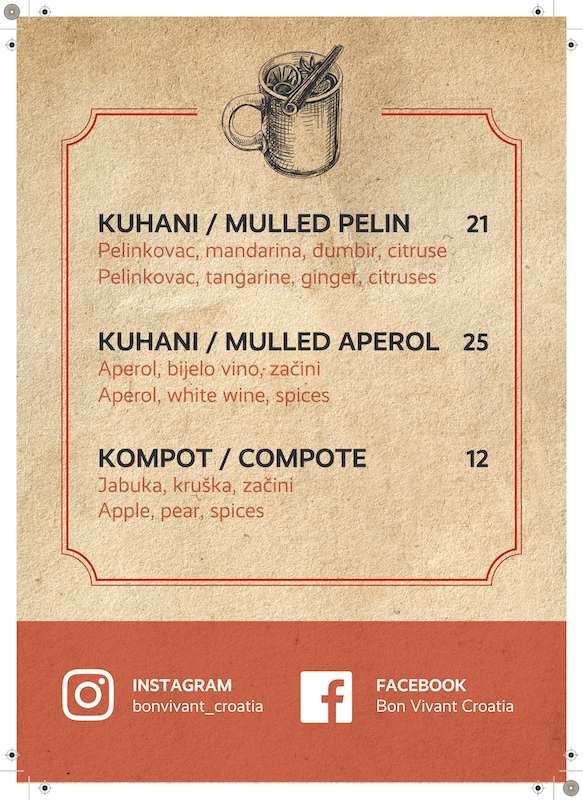
Pick-up points are a great way to safely enjoy the culinary pearls of Split while admiring the twinkling lights of Advent.
To read more about lifestyle in Croatia, follow TCN's dedicated page.
Flights to Croatia: Turkish Airlines Announces More Flights to Zagreb in January
December 17, 2020 - The latest news for flights to Croatia as Turkish Airlines announces more flights to Zagreb in January.
Croatian Aviation reports that Turkish national airline Turkish Airlines has announced its flight schedule for January 2021. Zagreb will be better connected with Turkey's largest city in the first half of January.
Turkish Airlines will offer significantly more flights to Zagreb compared to December this year. From January 1, the number of flights will increase briefly, until January 18, 2020.
From Friday, January 1, to Sunday, January 3, the Turkish national airline will operate four return flights to Zagreb, with two flights announced for Sunday, in the morning and the evening.
From Monday, January 4, to Sunday, January 10, the airline will have seven return flights to Zagreb, with two daily flights available on Monday and Sunday and one on Wednesday, Thursday, and Friday. Depending on the day, flights operate in the morning or evening.
From Monday, January 11, to Sunday, January 17, Turkish Airlines will operate five return flights, one on Monday, Tuesday, Wednesday, Friday, and Sunday.
From January 18 to 31, the number of flights will return to current levels, and Turkish Airlines will operate between Istanbul and Zagreb four times a week, every Monday, Wednesday, Friday, and Sunday.
However, thanks to the increase in the number of operations from January 1 to 17, Turkish Airlines will have more than 8,100 seats on sale between Zagreb and Istanbul in January next year, which increases capacity compared to December by almost 30%.
Given the excellent occupancy of aircraft on this route, the move by Turkish Airlines is no surprise. Aircraft type B737-800 has been announced for morning flights, while aircraft of higher capacity - A321 - will operate on the afternoon or evening rotation.
It should also be emphasized that the Airbus A321 has a capacity of 51.70 cubic meters of cargo space, which is important for all freight forwarders operating at Zagreb Airport and transporting cargo to and from Asian countries with Turkish Airlines. The cargo space of the B737-800 aircraft is slightly smaller and amounts to 44.1 cubic meters.
Turkish Airlines is also announcing four flights a week between Zagreb and Istanbul in February. Still, the flight schedule is subject to change and will depend on the epidemiological situation that directly affects demand itself.
For the latest travel info, bookmark our main travel info article, which is updated daily.
Read the Croatian Travel Update in your language - now available in 24 languages.
Creative Europe: Sibenik Fortress Restoration Shining Example
December the 17th, 2020 - The historic Dalmatian city of Sibenik has long been known as a shining star when it comes to the proper and creative use of European Union funds, and when it comes to the the Sibenik fortress restoration, it's difficult to find a better example.
As Lucija Spiljak/Poslovni Dnevnik writes, the success of the Sibenik fortress restoration, which regards the fortresses of St. Mihovil and Barone, has seen the two mighty structures placed on the list of 32 examples of good practice from the European Commission's Creative Europe programme.
The aforementioned programme is otherwise one of the most important publications of the European Union called Cultural Heritage in Action, which deals with programmes worth 1.46 billion euros for the cultural and creative sector.
The City of Sibenik is presented as an innovative city that has turned its imposing fortresses into exceptional tourist locations, settling well into the company of large European cities.
"We're extremely proud of the restoration of the fortresses of St. Mihovil and Barone, and the reconstruction of the third fortification building. Sibenik has become an example of good practice due to its excellence in the management of cultural assets, which is why we're proud,'' said Sibenik Mayor Zeljko Buric.
With the help of the Sibenik fortress restoration initiatives, Sibenik has managed to position itself as the cultural centre of Croatia, the fortresses have been revitalised and are some of the most visited historical monuments in all of Croatia, where numerous cultural events, concerts, screenings and more are organised.
The European publication also highlights the Club of Friends of Sibenik Fortresses, which connects the local population with the restored cultural heritage of the city.
For the latest travel info, bookmark our main travel info article, which is updated daily.
Read the Croatian Travel Update in your language - now available in 24 languages
Zagreb School Implements UN Sustainable Development Aims
December the 17th, 2020 - One forward-thinking Zagreb school has aligned itself with the UN's sustainable development aims and has, as such, entered the finals of the World Registry of Private Schools.
As Lucija Spiljak/Poslovni Dnevnik writes, the Vedri obzori International Primary School is the only Croatian school to have entered the finals of the aforementioned registry, which awards a diploma for a top humanities school. Among a total of 5,000 nominated schools from 56 different countries around the world, this Zagreb school entered the top five finalists.
School founder and principal Milena Prodanic Tisma says that this is a confirmation of their seven years of hard work and effort, but also a confirmation of their vision and approach in which the emphasis is placed on an individual approach to each student and in which the student is an active participant in the entire teaching process. This Zagreb school was founded back in 2013.
Since September this year, it has run the famous British Mindfulness and Wellbeing programme for students to ensure the psychophysical protection of students from the consequences of the ongoing pandemic, as was said in an interview with Poslovni dnevnik back at the end of July.
''This year we decided to go one step further by launching the Mindfulness programme while the Wellbeing programme has been one of the core components of our school right from the very beginning. The Mindfulness programme aims to help students in their daily work through the development of concentration, focus and productivity, and is intended for all students of our primary schools, ie from the first to the eighth grade. The first phase includes students from the second to the fifth grade, which we plan to upgrade to more grades.
The need to implement this programme stemmed from a deep understanding of the context with which students are surrounded today in their educational process, which is characterised by the hyperproduction of information and the expansion of communication channels. In such circumstances, it's crucial for students to have full psychophysical support provided to them,'' said the Zagreb school's principal.
The programme is being implemented in addition to the regular programme to support students in their daily work to develop their concentration, focus and productivity.
The Mindfulness in Schools project, set up by teachers from the UK’s most successful schools and also the most recognised provider of mental health training and curricula for schools, aims to improve children’s lives by contributing to their positive mental health. More than 350,000 students worldwide are involved in the MISP programme, which develops their academic, social and emotional skills.
The Mindfulness in Schools project considers mental health as important as other school subjects, and the coronavirus pandemic further confirms that the focus in education should be on students' mental health, which was recognised by the Vedri International Elementary School as the first in Croatia to do so.
Informatics has been introduced in the school since the first grade, and after their regular classes, students have the opportunity to choose many activities such as tennis, robotics, chess, art workshops, etc. This year they became the first elementary school in Croatia to introduce the goals of the United Nations (UN) for the sustainable development of their integrated into teaching as part of the curriculum.
"Our advantage is that we don't conduct classical frontal teaching after which the student goes home and learns for their assessment. Thus, for example, we use the innovative music curriculum Charanga to perform music, and in the teaching process, the mathematical programme Mathletics, which allows students to practice their mathematical skills, is used in a fun way through online "games".
We prefer innovative learning programmes because only this type of programme can develop the skills and competencies that students will need in the future. The transformation of the business world is taking place at a staggering pace, and when we add that to ubiquitous artificial intelligence (AI), which takes over all areas of activity, it's clear that classical learning doesn't provide students with enough space to develop thinking outside the box. AI will take over some of the work, but what it will certainly never be able to surpass is human creativity,'' the Zagreb school's principal stated.
For the latest travel info, bookmark our main travel info article, which is updated daily.
Read the Croatian Travel Update in your language - now available in 24 languages
Minister Tomislav Coric Praises Government Job Preservation Measures
December the 17th, 2020 - Minister Tomislav Coric has praised the Croatian Government's economic measure which was introduced in order to help employers preserve jobs during the pandemic, and he offered further comments on the duration of the now well known 4000 kuna per worker measure.
As Poslovni Dnevnik writes, the Minister of Labour, Josip Aladrovic, the Minister of Economy and Sustainable Development, Tomislav Coric, and the director of the Croatian Employment Service, Ante Loncar, came together to sign a contract for the “Stimulating education for related trades based on the PHASE II apprenticeship system'' project.
The aim of the aforementioned project is to improve and develop the model of education for occupations within the system of related trades, the solving of problems related to the lack of licensed natural and legal persons conducting apprenticeships, as well as the lack of motivation of economic entities to participate in the process of enrollment into occupations from the system of related trades.
"Aside from the associations which are representing the employers, we're going to hold a meeting with representatives of the main trade union centres in the context of the upcoming festive period and the eventual actions that we're going to be taking," announced Minister Tomislav Coric.
Measures to help the economy
Minister Tomislav Coric also commented on the duration of the Croatian Government's economic measures during the ongoing coronavirus crisis.
"This current phase we're in, despite the relatively positive numbers when it comes to new cases of infection in the past few days when comparing them to the week before, we believe that this measure will continue for some time. As long as phase A of the lockdown of part of the sector lasts, ie the reduction of economic activity in the country due to reduced revenues, the longer the measures to help the economy will last. Therefore, on the one hand, we've got the measure of 4,000 kuna per worker, on the other hand, we've got the measures to shorten working hours, and finally, we've got measures to cover part or all of the fixed costs of a company, depending on the level of their revenue decline.
That money will be provided for as long as we're witnessing such circumstances in regard to the functioning of the domestic economy. As circumstances change, new, possibly additional measures will be adopted, so that could mean that some of these measures will be abolished,'' he said, adding that everything depends on whether the epidemiological situation in the country improves or worsens.
Regarding the decline in the number of employees in Croatia, Minister Tomislav Coric pointed out that the country is at the same level as it was before the pandemic struck the country. "We don't have a significant increase in terms of unemployment. This first of all confirms the fact that Measure 3250, ie the ''4000 kuna measure'' hit the spot properly and made sure unemployment, despite the crisis that hit the whole of Europe, avoided hitting Croatia too significantly,'' Minister Tomislav Coric pointed out.
He also commented on the business and functioning of INA, which is an ongoing saga. "Unfortunately, over the last fifteen years, INA has been the subject of politics as a company, as has its very functioning, instead of being a subject of business,'' he stated briefly.
For the latest travel info, bookmark our main travel info article, which is updated daily.
Read the Croatian Travel Update in your language - now available in 24 languages


